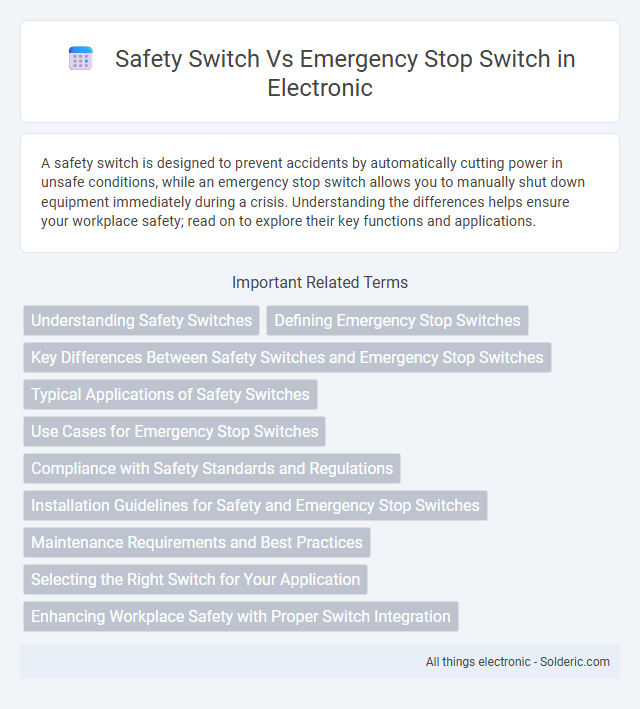A safety switch is designed to prevent accidents by automatically cutting power in unsafe conditions, while an emergency stop switch allows you to manually shut down equipment immediately during a crisis. Understanding the differences helps ensure your workplace safety; read on to explore their key functions and applications.
Comparison Table
| Feature | Safety Switch | Emergency Stop Switch |
|---|---|---|
| Purpose | Prevents electrical hazards by disconnecting power when safety is compromised | Immediately stops machinery or equipment in an emergency situation |
| Activation | Automatic or manual, triggered by unsafe conditions | Manual, activated by pressing a button or pulling a lever |
| Function | Isolates electrical circuits for maintenance or fault conditions | Shuts down equipment instantly to prevent accidents or injuries |
| Location | Installed on electrical panels, machinery power sources | Located in easy-to-access areas near equipment for quick response |
| Standards | Complies with IEC 60947-3, UL 508 | Complies with ISO 13850, IEC 60947-5-5 |
| Reset | Usually requires manual reset after activation | Requires manual reset following emergency stop |
| Usage | Routine safety isolation during maintenance or faults | Emergency intervention to protect personnel and equipment |
Understanding Safety Switches
Safety switches are designed to protect machinery and personnel by disconnecting power to equipment when a hazardous condition is detected, ensuring safe maintenance or emergency shutdown. Unlike emergency stop switches, which provide immediate manual power cutoff during emergencies, safety switches often include interlocks that prevent equipment from restarting until safe conditions are confirmed. Understanding safety switches helps you implement effective safety protocols to minimize risks and comply with regulatory standards.
Defining Emergency Stop Switches
Emergency stop switches are critical safety devices designed to immediately halt machinery operation in hazardous situations, ensuring instant power cutoff to prevent accidents. Unlike safety switches, which may control circuit power during maintenance or regular shutdowns, emergency stop switches prioritize rapid response to potential emergencies. Your facility's compliance with safety standards depends on strategically placing these switches for quick accessibility and maximum protection.
Key Differences Between Safety Switches and Emergency Stop Switches
Safety switches are designed to isolate electrical power to machinery or equipment for maintenance or in hazardous situations, preventing accidental startup, while emergency stop switches provide a fast and immediate method to halt machinery during an emergency to protect personnel from harm. Safety switches often incorporate lockout/tagout features for controlled access, whereas emergency stop switches prioritize quick accessibility and fail-safe operation, typically requiring manual reset after activation. Understanding these key differences helps ensure your facility complies with safety regulations and enhances workplace protection by deploying the appropriate switch type based on the specific risk scenario.
Typical Applications of Safety Switches
Safety switches are commonly used in industrial machinery, manufacturing plants, and conveyor systems to ensure equipment is de-energized during maintenance or emergencies, preventing accidental startup. These switches provide reliable isolation of electrical circuits, safeguarding workers from electrical hazards in environments such as HVAC systems, motor controls, and heavy-duty machinery. You will find safety switches essential for compliance with safety standards like OSHA and IEC, enhancing overall workplace safety.
Use Cases for Emergency Stop Switches
Emergency stop switches are designed for immediate shutdown of machinery or equipment during hazardous situations, ensuring rapid response to prevent injury or damage. Common use cases include manufacturing lines, robotics control, and heavy machinery operation where quick deactivation is critical. Your safety system relies on these switches to provide a fail-safe mechanism that overrides normal operations instantly in emergencies.
Compliance with Safety Standards and Regulations
Safety switches and emergency stop switches both comply with stringent safety standards such as ISO 13850 and IEC 60947-5-1, ensuring reliable machine shutdown mechanisms. Safety switches are designed for controlled access and safeguarding, often meeting OSHA and OSHA's electrical safety requirements, whereas emergency stop switches provide immediate machine halting in critical situations, aligning with EN 60204-1 regulations. Both devices are integral in industrial settings to fulfill compliance mandates for worker protection and hazard prevention.
Installation Guidelines for Safety and Emergency Stop Switches
Proper installation of safety switches requires mounting them in easily accessible locations near potential hazards to ensure immediate disconnection of power during unsafe conditions. Emergency stop switches must be installed within quick reach of operators, clearly marked, and positioned to allow rapid activation in emergencies. Your facility's compliance with OSHA and IEC standards for spacing, signage, and wiring enhances safety and ensures both switches function optimally in preventing accidents.
Maintenance Requirements and Best Practices
Safety switches require regular inspections to ensure contacts and actuators function correctly, with routine cleaning to prevent dust and debris buildup that could impair operation. Emergency stop switches demand frequent testing to verify immediate disengagement capabilities, alongside prompt replacement of worn or damaged components to maintain reliability. Implementing a maintenance schedule based on manufacturer guidelines and environmental conditions optimizes performance and compliance with safety standards.
Selecting the Right Switch for Your Application
Choosing between a safety switch and an emergency stop switch depends on the specific application requirements, such as the need for continuous monitoring or immediate shutdown during emergencies. Safety switches are designed to isolate electrical circuits and protect personnel during maintenance, ensuring compliance with OSHA and IEC standards. Emergency stop switches offer rapid machine shutdown in hazardous situations, often integrated with control systems to minimize risk and enhance workplace safety.
Enhancing Workplace Safety with Proper Switch Integration
Safety switches and emergency stop switches play distinct yet complementary roles in enhancing workplace safety through proper integration. Safety switches monitor machinery status to prevent unauthorized access or hazardous conditions, while emergency stop switches provide immediate shutdown capability during critical situations. Ensuring your facility incorporates both types of switches optimizes hazard control, reduces injury risks, and supports compliance with industrial safety standards.
Safety switch vs Emergency stop switch Infographic

 solderic.com
solderic.com